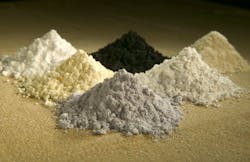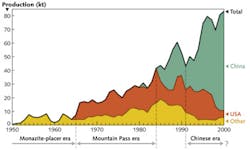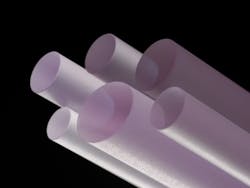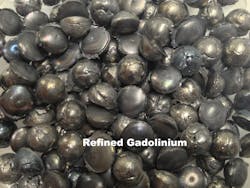PHOTONICS APPLIED: PHOTONIC MATERIALS: Chemical element availability impacts the future of photonics
We all read and learn daily about the rare-earth and other chemical elements that play such a huge role in the photonics industry. Germanium (Ge), indium (In), gallium (Ga), and arsenic (As) are used routinely in semiconductor, photovoltaic thin-film, and photodetector devices, while yttrium (Y), ytterbium (Yb), and other exotic-sounding elements power solid-state and fiber lasers. What is the availability of these chemical elements and what nations control pricing and supply? Furthermore, what are the environmental issues surrounding the processing or purification of these elements from bulk mined materials? The answers are important to the future health of the photonics industry.
Assessing risk
In my December 2012 Photon Focus blog entitled "Holmium for the holidays," I remind the photonics community that chemical elements—and especially the rare earths—keep our photonics industry humming. The online periodic table of the elements (www.rsc.org/periodic-table) from the Royal Society of Chemistry (RSC; London, England) puts most of the rare-earth elements including holmium (Ho), cerium (Ce), neodymium (Nd), erbium (Er), and thulium (Tm) in the "high risk" supply category.
Although many of these rare-earth elements are abundant in nature (for example, Ho concentration is 1.3 mg/kg of earth—more than 20 times more abundant than silver according to www.lenntech.com/periodic/elements/ho.htm—caustic and environmentally unfriendly processing methods have essentially killed European and American extraction. As of the year 2000, the US Geological Survey (USGS; Reston, VA) says that China supplies more than 90% of the rare-earth elements (see Fig. 1).Roskill Information Services (London, England) says that China will continue to lead the conversation in rare earths.1 "The dominant metals, accounting for nearly 70% of global demand for rare earth oxides, remain cerium and lanthanum," says Roskill. "China is the largest market for rare earths and metals and demand is increasingly from higher-value applications, such as magnets and phosphors, rather than lower-value applications in metallurgy and agriculture."
Because the magnet market is the main driver for Nd demand, for example, Nd:YAG crystal growers must carefully watch nonphotonic market demands. And photonic phosphor supply issues prompted Osram Sylvania (Danvers, MA) to issue a report entitled "Rare Earth Phosphor Crisis" in late 2011, emphasizing how supply issues for europium (Eu) and yttrium (to generate red light); cerium (Ce), lanthanum (La), and terbium (Tb) (to generate green light); and europium (to generate blue light) phosphors will put a major crimp in red/green/blue (RGB, otherwise known as white light) fluorescent light production. How dire was the pricing situation? From January 2010 to June 2011, the price of cerium oxide rose 3530%!
With the majority of the global supply of rare-earth elements under China's lock and key according to an Industrial Minerals (London, England) article in late 2012, export quota restrictions are in place and the Chinese Ministry of Commerce (MOFCOM) is continually adjusting export limits.2 Fortunately, prices are expected to stabilize for many rare earths in 2013 as new supply channels become available.
Critical uses
The precious metal iridium (Ir)—with an RSC "high risk" supply rating—is the key heat- and chemical-resistant element for high-temperature crucibles used to grow high-purity crystals. Johnson Matthey (London, England) manufactures crucibles with up to 6000 cc volumes that can be used to grow YAG-based crystals for solid-state lasers, sapphire crystals used for everything from barcode-scanner windows to blue and green light-emitting diode (LED) substrates, lithium-based crystals used in surface-acoustic-wave filters, gadolinium gallium garnet (GGG) crystals that improve over common semiconductor memory chips by being able to withstand a nuclear blast, and scintillation crystals used in medical scanners.
From 2005 to 2011, Ir prices jumped (according to InfoMine at www.info mine.com/investment/metal-prices) from $150 per ounce to nearly $1100 per ounce, causing crystal growers to rethink production capacity increases. A MetalMiner article from mid-2011 blamed the price increases (which started in early 2010) on crucible production increases to meet the demand for LED backlights used in tablet and TV displays, noting that electrical industry demand for iridium in 2010 showed 27 times the demand of 2009.3
The demand-based price increases for iridium and other rare-earth elements are a great indicator of LED success, but bad news for companies growing laser glass (see Fig. 2). "In addition to Ir for our crucibles, we use the oxides of Nd, Y, Yb, Th, and Ho—most important being Nd and Y," says Paul Collins, president of Laser Materials (Vancouver, WA). "China has attempted to limit the export of these materials in order to encourage their use within China in important new technologies; however, the increasing prices have encouraged the reopening of mines outside of China, and this has caused some easing of prices and supply constraints in recent months."Collins adds, "In the long run, China may influence the pricing and supply, but I doubt they can maintain the complete control they have had during the last couple of years." To purify the bulk materials it sources from China, Laser Materials relies on a Japanese company.
With the highest magnetic moment of any of the rare-earths, Ho metal is used to build ultrastrong magnets and absorb nuclear-fission-created neutrons; it is also a critical dopant material in solid-state and fiber lasers that are used in laser-based surgical applications.
Wikipedia says that Ho is relatively inexpensive for a rare-earth element at about $1000/kg. But the problem for the rare earths is not always the current price—it is the dramatic price increases underway and the expense of having the bulk materials purified to meet application requirements. Praseodymium (Pr), for example, has risen from $18/kg in 2008 to $320/kg in 2012 and is used in welding goggle glass, in carbon arc lights for studio and projector lighting, and like Ho, is an ingredient in optical fibers for amplifiers and fiber lasers. As prices rise (or fall), manufacturers of rare-earth-based items are left scrambling; trying to manage price fluctuations.
Aside from the rare earths, other more common photonic elements are experiencing supply and pricing issues. In mid 2012, Popular Mechanics asked "Why Is There a Helium Shortage?" The answer: Demand is outpacing the supply. In summary, the US federal government (which sets He prices) stated that He—one of the most abundant elements in the universe—will rise in price from nearly $76 per thousand cubic feet (Mcf) in fiscal year 2012 to nearly $84 per Mcf in fiscal 2013. A byproduct of natural-gas production, 75% of the world's He comes from the US; specifically, any new reserves are stored near Amarillo, TX, and distribution is managed by the Federal Helium Program. Quite simply, the demand for He continues to increase and price increases consequently follow.
Why the growing demand for He? In addition to its uses in cryogenics (like keeping magnetic resonance imaging or MRI magnets cool) and high-energy particle accelerators, He is also a key photonic ingredient in helium-neon or HeNe lasers and carbon-dioxide (CO2) lasers in which the beam is produced by exciting a mixture of CO2, He, and nitrogen (N). For 2012, CO2 lasers still represented a more than $1 billion dollar share of the more than $8 billion dollar total laser market.
Helium is also critical to semiconductor manufacturing. In August 2012, the Semiconductor Industry Association (SIA; Washington, DC) penned testimony to a congressional subcommittee on the importance of helium to the US economy, national defense, and manufacturing for its critical use as a carrier gas for deposition processes, as a dilutant gas in plasma etch processes, in some specialized wafer cooling applications, for controlled-environment leak detection, and to achieve ultraclean manufacturing and assembly environments that are essential for advanced semiconductor manufacturing. "According to a report of the National Academy of Sciences, semiconductor and optical fiber manufacturing account for 13 percent of uses of helium," the testimony exclaimed.
And how could the photonics world function without silicon (Si)? From semiconductors to solar photovoltaic panels and substrates for all things organic and inorganic, Si drives the photonics industry. Silicon at 99.9% purity (three nines or 3N) can be used for solar cells, while 99.9999999% (9N) purity is required for semiconductors. But aside from the processing issues to achieve such purity, silicon—the second most abundant element in Earth's crust according to Wikipedia—is plentiful in nature.
Improving supply stability
Although some elements are abundant, the supply of many critical photonics elements is limited and new reserves will have to be discovered, mined, and processed—possibly with damaging environmental consequences. In my own backyard I've seen gold-mining operations grow from small-scale, ant-farm-like tunnels barely visible on the surface with negligible environmental impact to large-scale, cyanide-leaching operations that create hundreds-of-feet deep open pits and tens-of-miles-long, pyramid-shaped leach hills that forever change the landscape and threaten water supplies.
To increase rare-earth element supplies, non-Chinese nations are being pressured to step up mining operations. In the US, Rare Element Resources (Lakewood, CO) commenced operations on its Bear Lodge property in Wyoming that holds significant resources including La, Ce, Pr, Nd, samarium (Sm), Eu, and Gd. Molycorp (Greenwood Village, CO) is also ramping up operations on a mining area just north of the historic Mountain Pass, CA, location. Projects are also progressing at a fast pace in Australia, Malaysia, and Canada.
As Paul Collins indicated earlier, these additional resources are already having an impact on raw materials, with the price of many rare-earth elements dropping. A late 2012 Wall Street Journal article opens with, "Companies that bet on rare earths as a hot commodity play are canceling investments or switching attention to other metals like gold after being caught by a sharp fall in prices this year," citing the three- to five-fold price decreases of lanthanum-, cerium-, and neodymium oxide. However, the article sums up the rare-earth situation by saying, "It's a niche space that is proving difficult and is fraught with a high level of volatility."
In the case of He, new gas fields are being discovered that will offset some of the effects of the old ones closing, according to the welcome article in the December 2012 AILU eNewsletter from Jim Fieret, head of laser development and marketing for The Linde Group (Munich, Germany). Formed by the radioactive decay of thorium and uranium, He is quite plentiful in nature; Fieret assures the reader, "We are not running out of helium. So, don't scrap your CO2 laser just yet!"
While the alternative to mining is finding substitute materials or recycling where possible, these alternatives take time. Furthermore, once the product is mined, processing it to reach required purity levels for various industrial applications is another cost and supply issue. "For photonics applications, a purity higher than 3N or 99.9% is typically needed; separation of the metals is not easily accomplished and typically not undertaken by Asian vendors," says Michael Lebby, general manager and CTO of Translucent (Palo Alto, CA), a materials technology company with a focus on optoelectronics and solar markets. "Asian vendors typically want to supply a rare-earth mixture in a single lump form, with limited purity for any desired element."
Lebby says that as a user of rare-earth metals such as Er, Nd, and Gd, Translucent relies on the US Department of Energy (DOE) Ames Laboratory (Ames, IA) to enhance the purity of the lump metal supplied from Asia and recast it into a more usable, reproducible form factor such as pellets (see Fig. 3). "Translucent typically requires that all incoming material be re-assayed as supplied certificates are limited to a few elements. In essence, the industry needs to look at the whole supply chain, and in the absence of domestic mining, be able to focus on quality control through support of groups like the Ames lab," concludes Lebby.In fact, the rare-earth supply situation has prompted the US DOE to launch a $120 million dollar rare-earth metals research hub to be located at the Ames Laboratory that will seek new ways to improve rare-earth supply through new resources, more efficient use of these elements in manufacturing, and in recycling and reuse programs. A BBC article on the facility notes that today, there is very little recycling done (not even 1%) and concludes, "At the moment, there are no really good environmentally friendly methods available to mine and to recycle rare earths."
REFERENCES
1. "Rare Earth Special: 'China will continue to lead conversation in rare earths,'" Industrial Minerals (November 2012).
2. E. Hughes, "Rare Earth Special: Projects in the Pipeline: Rare earths light up global markets," Industrial Minerals (November 2012).
3. T. Berezowsky, "Iridium's Price Skyrocketing—What Does It Mean?" MetalMiner Industry News (May 18, 2011).

Gail Overton | Senior Editor (2004-2020)
Gail has more than 30 years of engineering, marketing, product management, and editorial experience in the photonics and optical communications industry. Before joining the staff at Laser Focus World in 2004, she held many product management and product marketing roles in the fiber-optics industry, most notably at Hughes (El Segundo, CA), GTE Labs (Waltham, MA), Corning (Corning, NY), Photon Kinetics (Beaverton, OR), and Newport Corporation (Irvine, CA). During her marketing career, Gail published articles in WDM Solutions and Sensors magazine and traveled internationally to conduct product and sales training. Gail received her BS degree in physics, with an emphasis in optics, from San Diego State University in San Diego, CA in May 1986.



